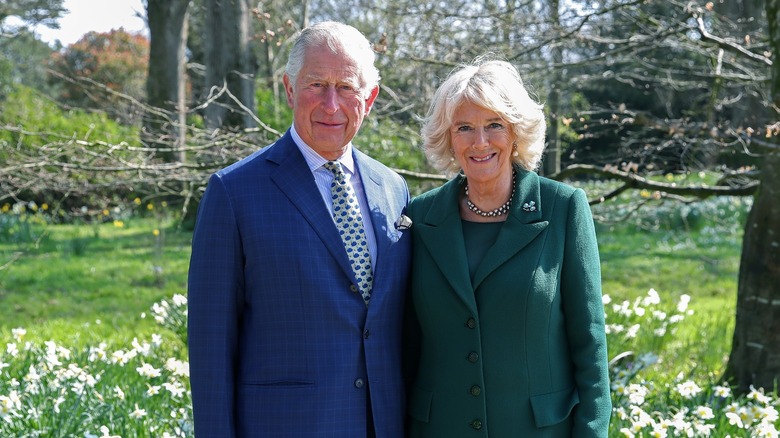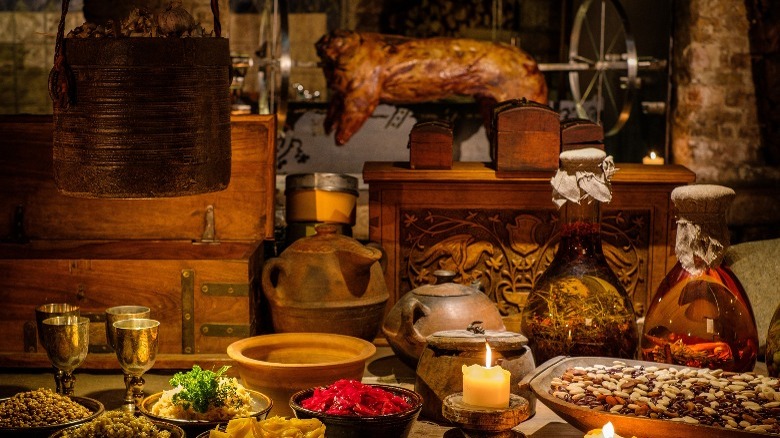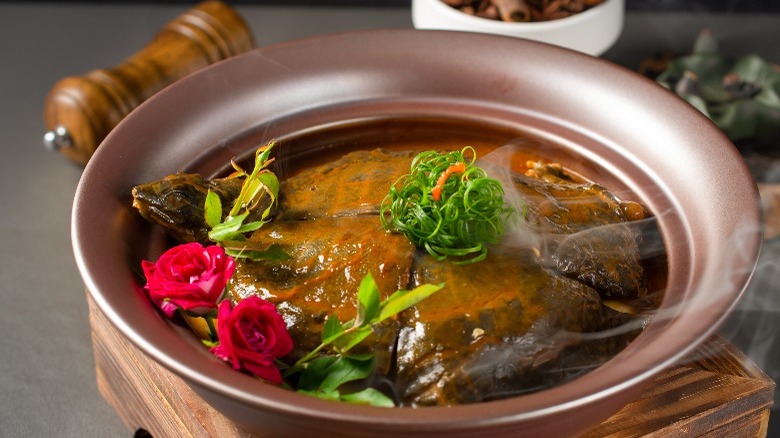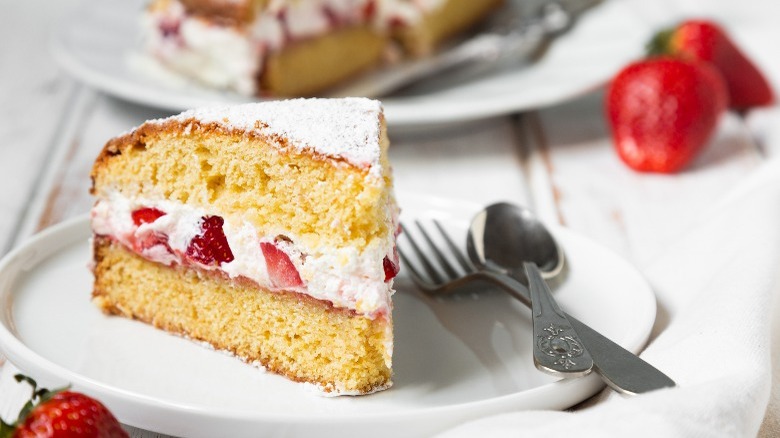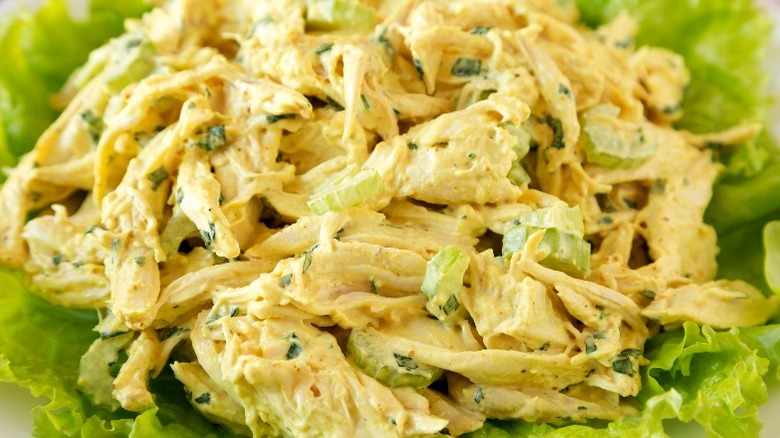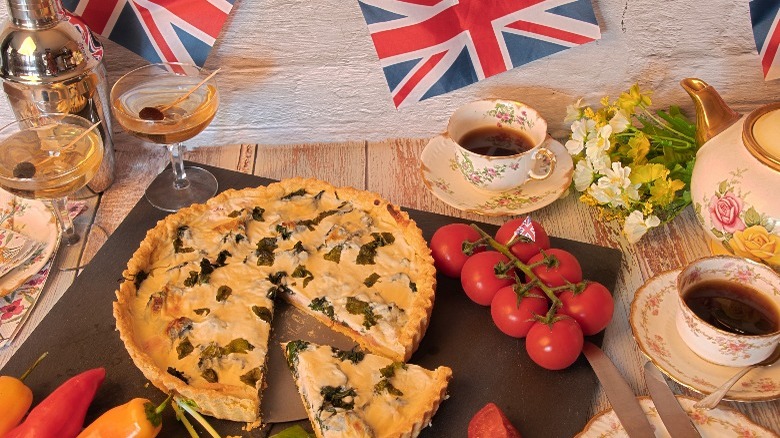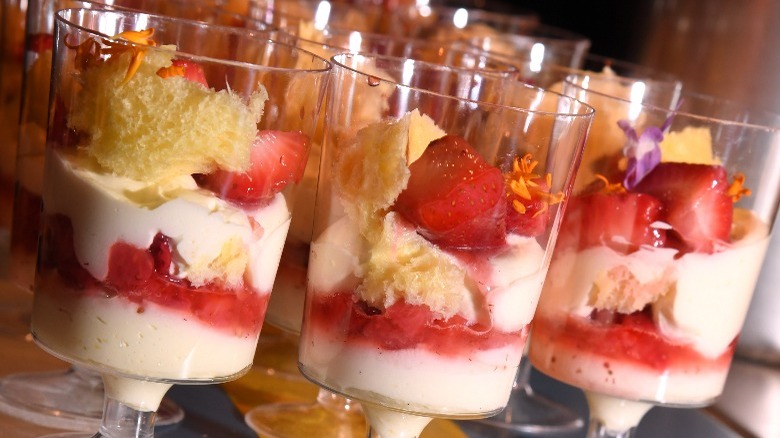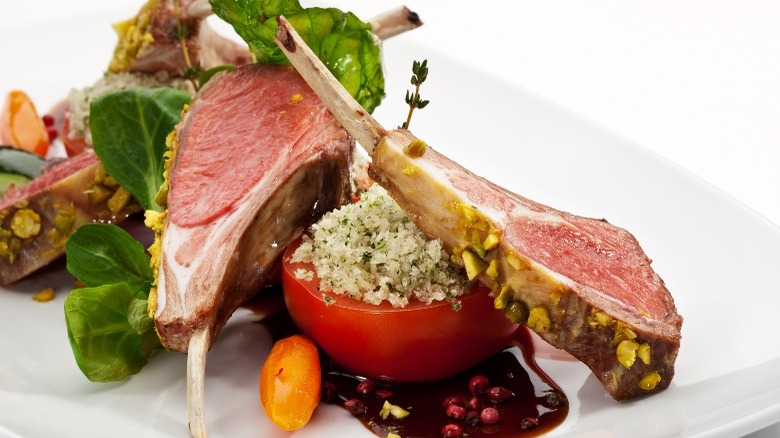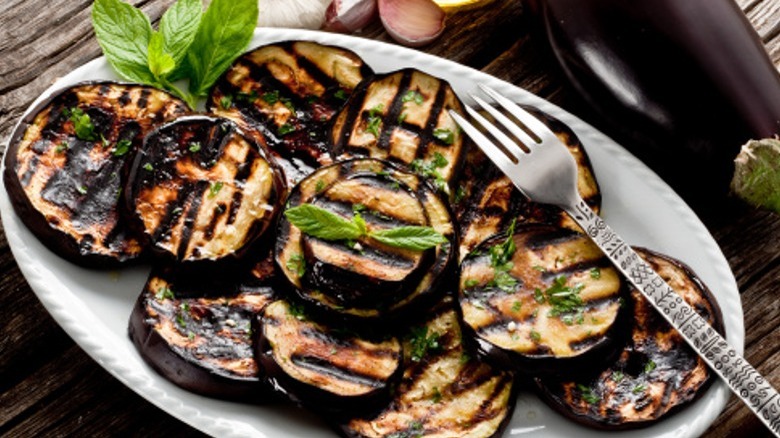10 Famous Coronation Dishes Throughout History
Only a small number of lucky individuals have the right pedigrees to be invited to coronations, and everyone else gets to watch them on television. And even though the attending royals, their fabulous clothes, and priceless jewels garner most of the attention, the food served on this auspicious day is also the stuff of legends.
Westminster Hall was the site for many a lavish coronation banquet, starting with the one held for Richard I in 1189. The last one held there in 1821 for George IV was thought to be the most spectacular of all time. Many historic coronation feasts lasted several days, but after George IV was crowned, the banquets started taking place at Buckingham Palace and became more low-key.
King Charles' Coronation Big Lunch wasn't anywhere near as flamboyant as George IV's coronation. Historians have made educated guesses about food served at the earliest coronation banquets, and there are some famous ones we know more about. Here's the lowdown regarding the most famous past and present Royal Coronation dishes.
The first coronation dishes
One of the first recorded coronations in history took place in 973 A.D. when Edgar the Peaceful was crowned in Bath. On that day, the Archbishop of Canterbury officiated this ceremony for the new King of All England. It was the first time a king was declared "recognized by God" and given rule over all of Britain.
The year 973 A.D. was in Medieval Times, specifically in the Early Middle Ages which took place from 500 to 1050 A.D. Though no one seems to have saved the menu from the 973 coronation, well-heeled noblemen from back then likely enjoyed fresh fruits and vegetables, freshly killed meat and fish, dried fruits, and cane sugar. Coronation banquets might have also had more unusual, showy foods like roasted peacocks and porpoises. While these might not have tasted very good, they were probably used as fanciful displays of wealth. Fortunately, neither of these will likely be on the May 6 menu. Many of the historic coronations offered other dishes that might seem outdated and unpalatable in 2023, as you'll see in a moment.
Snipe
Although the word snipe means to criticize and certainly sounds less than appetizing, it was a royal delicacy back in the day. Snipe is a long-billed, plump shorebird found in North America, South America, and Eurasia. It has long legs, pointy wings, and brown, white, and black feathers. The traditional way to prepare snipe is plucked and roasted whole, with the guts intact. And as for the way it was eaten, the method was not for the faint-hearted. Coronation attendees might have eaten the leg and breast meat, and then gone in to finish the entrails. The snipe's head was also cut in half, and the brain would be removed and eaten.
Yes, that sounds quite disgusting — all the more when you consider how many medieval celebrants probably weren't using knives and forks. But an account of Edward VII's August 1902 Coronation describes a much more civilized snipe presentation. Instead of being the whole bird, guests were served glorified snipe cutlets. These were cooked inside pork fat (caul) and cooked with pâté and brandy. That was topped with breadcrumbs and truffle sauce, with side dishes of more truffles, mushrooms, and beans. It seems the chefs hid the snipe inside all of those other good things, and we're assuming that there was a very good reason for that.
Turtle soup
Turtle soup was a delicacy in the days of King George IV, and at his over-the-top 1821 coronation, it was one of the 20 first courses served. It was shown as Potage de Tortue a l'anglaise on the menu, and the kitchen used 200 pounds of fresh turtle meat for this soup. It was served alongside warm pâté, fillet of sole in champagne sauce, and other gourmet dishes.
Like snipe, turtle soup doesn't hold a place on modern menus, and most Europeans and Americans likely find both objectionable. But the English aristocracy and other elite populations considered it to be haute cuisine in the 1700s and early 1800s. Caribbean green sea turtles were sourced for the meat, but they were overharvested and today, killing or harming them is illegal. In King George IV's era, green sea turtle fins were prepared separately in broth, with onions and herbs like nutmeg and cloves; there may have been other preparations as well.
Turtle soup can still be found in parts of the world like New Orleans, though. The meat might be cubed and sautéed in butter with vegetables like onions, celery, and pepper added in and cooked until soft. Beef broth, tomatoes, and seasonings would be added next, and the soup would simmer until serving.
Victoria Sponge Cake
Victoria Sponge Cake will likely make an appearance at the May 6 coronation, even though i's alleged that the first sponge cakes were made in Spain during the Renaissance era. There are records of sponge cake being in England in 1615, but this was before the 1843 invention of baking powder, an addition that made the cake fluffier and richer. It wasn't served at Queen Victoria's 1838 coronation, but she liked this cake so much that it was subsequently named after her. Since then, it's become a popular favorite dessert that's been served countless times at Buckingham Palace.
Victoria Sponge Cake is also popular with the masses, and isn't a difficult dessert to make. The basic sponge cake batter ingredients are eggs, sugar, butter, and sifted flour. Once those are baked and completely cooled, a layer of rich buttercream and jelly is layered on top of one. The second cake layer goes right on top and the whole thing can be topped with powdered sugar or icing. It's a great cake to make because it's so easy. Serve it while watching the coronation, and don't forget the fresh berries and pot of Early Grey.
Coronation Chicken
Coronation Chicken was introduced at Queen Elizabeth II's June 2, 1953 Coronation. This lunch entrée, served cold, was created by a florist-turned-culinary school owner Constance Spry and her colleague Rosemary Hume. Spry bought Le Petit Cordon Bleu Culinary School in 1945, and the two women were running it when the Royals came a-calling.
It's unclear if the Coronation Chicken recipe was created by Spry, Hume, their students, or a combination of them. The students were the ones who prepared it en masse, and based on its fame, they obviously did a fabulous job. Like Victorian Sponge Cake, Coronation Chicken is a simple dish that doesn't take long to make. It's an upgraded chicken salad with a delicious curry cream sauce. But instead of the usual mayo seen in chicken salad, that's swapped out for crème fraîche. The other ingredients are shallots, dried apricots, red wine, lemon juice, sugar, and curry powder. So it's sweet, sour, tangy, and earthy, all in one.
This is one of those recipes that can be changed up in different ways, by combining light and dark meat and adding things like fresh green peas or grapes. You can still find it on British menus to this day — a London restaurant, Quality Chop House, makes theirs without crème fraîche, opting for sultanas and almonds instead. They serve this on thickly-sliced bread instead of in salad bowls.
Coronation Quiche
The saying "let them eat cake" is most often attributed to Marie Antionette, but a more appropriate catchphrase for coronation might be "let them eat quiche." And interestingly enough, the Coronation Quiche recipe was shared by none other than King Charles and Queen Camilla.
This is a very appropriate dish for an understated coronation luncheon. Buckingham Palace probably shared the quiche recipe in order to bring it to the people — there's no better way to encourage their subjects to serve it during their own celebrations that day. It sounds pretty tasty, too. The from-scratch pastry shell is made with regular flour, cold butter, milk, and lard. But if you want to use a store-bought prepared pie shell, no one will be the wiser. The eggy filling also includes cheddar cheese, broad or soya beans, cooked spinach, and milk.
The Coronation Quiche filling also calls for double cream, which is a British food staple made with about 50% fat. Instead of that you can use heavy whipping cream or crème fraîche. For a lower-fat version, try Greek yogurt or coconut cream but don't expect the quiche to taste as rich. Salt and pepper the filling to taste, but the only herb shown in the recipe is freshly chopped tarragon.
Adam Handling's Strawberry and Ginger Trifle
This delectable concoction, which makes the most of British ingredients like Yorkshire Parkin cake and Scottish strawberries, has been chosen as the Coronation's official dessert recipe. If you're not familiar with Yorkshire Parkin, it's similar to gingerbread but made with oats and black molasses. It's an old recipe, with a robust flavor profile and chewy, sticky texture that pairs beautifully with creamy trifle ingredients.
The creator of this dish, Adam Handling, is a well-respected British chef and restaurant owner who was born in Scotland. He has many awards to speak of, including British Culinary Federation Chef of the Year and Restauranteur of the Year (the latter being an award voted on by industry judges and the public). He creates his Yorkshire Parkin from melted butter, brown sugar, and molasses. Dry ingredients like oats are added and the mixture is then baked. It's topped with a mixture of gelatin and blended strawberries and finished with ginger-infused custard and cream. It's not quite like a Victorian Sponge Cake, as that's a trifle, but compare the two and decide for yourself.
Coronation Cookies
What would a Coronation Big Lunch be without cookies? The Palace hasn't shared any of these recipes, but chances are good that they will be offered to the guests. Coronation Cookies will likely be seen all over England that day too, at restaurants and other events like street parties. A basic version would use a shortbread recipe with cookies cut into basic rounds or fun shapes like crowns and profiles of King Charles' head. They can then be decorated with icing or jellied candies cut out to resemble jewels.
Coronation cookies are big business in England, so bakeries are also gearing up for the big day. There are coronation cookie cutter sets and cookie embossing stamps and kits for sale. Walker's Shortbread has also made commemorative coronation tins with their regular shortbread cookies inside. There are two different tins -– one has a royal portrait of King Charles at the Highland Games, and the other shows him at the Cadet Force 150th Anniversary. Both are hot items and collectors have been clamoring to get them. It might be too late to order these, but there's still time to bake DIY versions.
Ken Hom's Coronation Roast Rack of Lamb With Asian-Style Marinade
It's been reported that this savory entree will be served at the Coronation Lunch, even though this information hasn't been confirmed on the official Coronation website as of yet. Reports have been coming in that chicken won't be on the menu and lamb will, but only time will tell. This dish is making the rounds because it supports British sheep farmers, local produce, and East-West flavors. And it sounds absolutely delicious, too.
So who is Ken Hom? He's another celebrated global celebrity chef and a well-known authority on Chinese cuisine. Born in Arizona, he was profiled by the New York Times in 1981 and starred on the BBC television series Ken Hom's Chinese Cookery. He's also authored close to 40 books and sells his namesake woks that are used all over Britain. His dish is made with two racks of lamb browned in peanut oil. Those are marinated in roasted sesame oil, soy sauce, garlic, chicken stock, peanut butter, and other ingredients. It only has to be cooked for half an hour at 400 degrees, but it should rest for 20 minutes before it's deglazed, sliced, and served.
Nadiya's Coronation Aubergine
An aubergine is the same thing as an eggplant but it goes by another name across the pond. The most popular ones have that deep purple shade, but there are also green, yellow, orange, and lavender ones. It's rumored that this vegetarian dish will be served at the Coronation, but the Palace hasn't officially confirmed this yet, either.
This recipe comes from Nadiya Hussain, a British chef and television personality whose father owned an Indian restaurant. She gained notoriety by winning "The Great British Bake Off" in 2015, and has gone on to make frequent TV appearances and become a published author. Her colorful Coronation Aubergine recipe might serve as the perfect counterpoint for meat-heavy coronation dishes. To make this dish, Hussain grills sliced, generously-oiled aubergine in a griddle pan, and tops them with a yogurt-based mango chutney sauce. She adds garlic and curry powder for earthiness and tops the whole thing with fresh coriander, raisins, and crisp, fried onions. What an incredible mix of flavors and textures.
